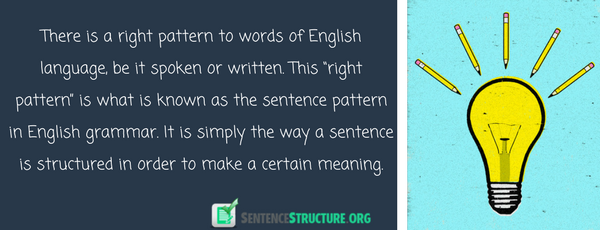There is a right pattern to words of English language, be it spoken or written. This “right pattern” is what is known as the sentence pattern in English grammar. It is simply the way a sentence is structured in order to make a certain meaning.
In this piece, the focus will be on what a sentence pattern really is:
- Sentence pattern examples
- What grammar mistakes can be made in English sentence pattern
- Correcting English sentence pattern with the grammar analysis tool
What Is a Sentence Pattern?
A sentence pattern is how a sentence is structured using different parts of speech. There are about six different sentence patterns in English language known as the basic sentence patterns.
They include:
- Noun/verb
- Noun/verb/noun
- Noun/verb/adverb
- Noun/linking verb/noun
- Noun/linking verb/adjective
- Noun/verb/noun/noun
From the patterns outlined above, one can see that sentence patterns in English grammar are made of noun, verb, and adverb being tossed around.
We will take them one after the other in details for a better understanding of how they function as grammar sentence patterns:
Here are some phrases that serve as examples of the noun/verb sentence pattern:
- John smokes
- Students study
- People ran
Generally, the noun/verb pattern sentences are as simple as just two words put together, one a noun, the other a verb. To make things more interesting, these Basic English grammar sentence patterns can be modified by adding other elements like a noun phrase, possessive adjective, and others.
Here are some modifications to the simple noun/verb sentence patterns listed above:
- John smokes – my friend John smokes
- Student study – our students’ study
- People ran – our athletes ran
As you can see in the sentence pattern in English grammar examples, the modified sentences are basically the same as the earlier ones. The only difference is that the second ones are more precise than the first.
Here are some examples:
- Tony jumps rope
- The children are making pastries
- He sleeps in the house
So, there is a noun, a verb, and a noun that can take objects in the noun/verb/noun as you can see in the example of sentence pattern above.
Examples of the noun/verb/adverb sentence pattern are:
- Laura ate very fast
- He talks carefully
- Jane jumps high
From the instances above, the terms fast, carefully, and high are all adverbs describing the noun/verb structures, making them noun/verb/adverb structures.
Here are some sentence pattern with examples:
- Toby is a sailor
- Kenneth will become Stephanie’s husband
- France is a country
Linking verbs are also known as equating verbs that can equate one thing with another as can be seen in the illustrations above.
Here are a few illustrations:
- The children are unhappy
- My dog is slow
- The math problem seem easy
The linking verbs here, just like in the noun/linking verb/noun sentence pattern, can also be referred to as equating verbs.
Here are some examples of a noun/verb/noun/noun grammar sentence pattern:
- Mother bought Thelma a gift
- I showed Vin my car
- His father taught him how to drive a car
There are other complicated sentence patterns than the six that have been illustrated in the piece, but these are the basic ones that all other patterns are formed from.

Grammar Mistakes That Can Affect the Credibility of Your Writing
There are a lot of people that love to write but are not concerned about grammar. As a matter of fact, trying to focus on the grammatical correctness of your paragraphs can but a bit of a strain on your writing flow and creativity. That is why many prefer to go right from the beginning to the end and make the necessary corrections thereafter. Despite how much focus and fun it takes away from ones way of writing, basic sentence pattern in English grammar is something every writer should take into consideration if the aim is to gain effective communication and respect from the readers.
Some of the grammar mistakes that can kill one’s credibility as a writer are:
- Subject-verb agreement: it is a rule that the subject and verb of a sentence agree with one another in quantity, be it singular or plural. The verb is only singular if the subject of the sentence is singular and plural only when the subject of the sentence is plural.
Here are some examples:
Right: An important thing in her life has been family
Wrong: Her two favorite colors are red and pink
Right: Her two favorite colors are red and pink
- Sentence fragments: sentence fragments are incomplete sentences that do not have an independent clause. Usually, it lacks either or both a subject or a verb. Since it has no independent clause, it cannot make a meaning on its own. A normal sentence pattern in English language is such that every sentence fragment depends on preceding sentences to give it a meaning.
Here are some illustrations:
Right: In spite of her disloyalty, he protected her interest
Wrong: They were willing to stay out till late in the night. Despite the consequences
Right: They were willing to stay out till late in the night, despite the consequences
- Comma in introductory elements: there are different ways of using a comma in different English writing pattern, one of which is after an introductory element. Throwing in commas (and punctuation market in general) without considerations causes confusion to the reader. Not using them in the right places can equally cause the same effects. Basic sentence pattern in English grammar demands that an introductory word, a phrase, or a clause be followed by a comma to give the reader a slight pause, help avoid confusion, and ultimately convey the right message as intended by the writer.
Here are some illustrations:
Right: In case you are interested, I can help you take care of your dogs
Wrong: Before he could say no his mother already said yes
Right: Before he could say no, his mother already said yes
Misuse Of “Its” And “It’s”
A lot of time, writers tend to use “its” in place of “it’s”, and that can put the reader off. “It’s is a short form for “it is” or “it has”, while “its” means “belongs to it”.
Wrong: It’s going to be interesting
Right: It’s (it is) going to be interesting
Wrong: It’s been a long time coming
Right: It’s (it has) been a long time coming
Wrong: The cat is licking its tail
Right: The cat is licking its tail
Correcting a Sentence Patterns with Our Free Tool
From the little that has been mentioned about common mistakes in the basic sentence pattern in English grammar with examples, as well as other mistakes, it is humanly to say that anyone is prone to making such mistakes; even the best writers. Everyone needs their work edited, and it takes time and resources in most cases to do so; which by the way is worth it. However, our free grammar checker tool and sentence type identifier can do all there is little time, and with fewer resources. This is a free compound complex sentence checker that can easily be downloaded for free to take care of all the grammar problems any writer could possibly have.













